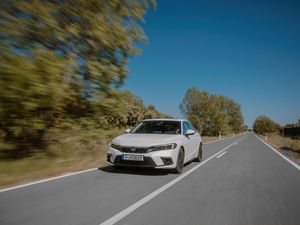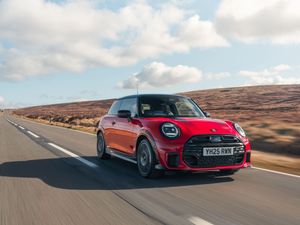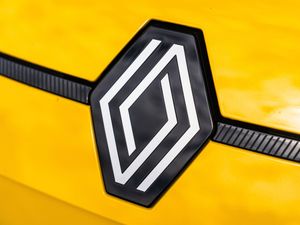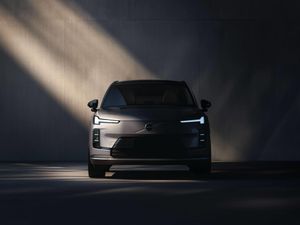First Drive: Can the Honda Civic rule the roost in the family hatchback class?
Honda’s new Civic brings some big advancements. Ted Welford heads to Madrid to see how it stacks up.

What is it?

>
Few cars have stood the test of time quite like the Honda Civic, which is this year celebrating 50 years of continuous production – more than pretty much any mainstream car on the market.
Spanning 10 generations, Honda has always managed to keep the Civic relevant, with the model growing from a small hatchback to a far larger car with an almost saloon-like appearance. Now Honda is back with a new 11th iteration, bringing with it a whole range of advancements to ensure it can remain competitive in what remains an ultra-popular segment, particularly to retail customers. But is Honda on to a winner with its Civic or not? Let’s get behind the wheel and find out.
What’s new?

>
It’s pretty rare for any ‘next generation’ car to launch these days without an electrified option. The Civic is no different, with Honda now exclusively selling the model in Europe with a newly-developed hybrid powertrain – meaning all its cars sold here are now electrified. That will change at the start of next year with the purely-petrol Type R version, though.
Though the Civic’s design on the outside hasn’t changed dramatically, there are plenty of other changes that have come into play – not least a new touchscreen that replaces the appalling system found in this hatchback before. With the closure of Honda’s Swindon factory last year, this is also the first Civic in some time that hasn’t been built in Britain.
What’s under the bonnet?

>
Though Honda had a wide range of hybrid powertrains readily available, it developed a new system for the Civic. There’s just the one option offered – a 2.0-litre petrol engine paired with two small electric motors and a battery for a combined 181bhp and 315Nm of torque. It’s brisker than the previous 1.5-litre petrol Civic, with 0-60mph taking 7.9 seconds in our Advance car, and capable of a 112mph top speed.
As for fuel efficiency, the Civic fares very well, with CO2 emissions of 114g/km on our top-spec test car, or just 108g/km on models fitted with the smaller wheels. Honda also claims 56.5mpg, though we quite easily exceeded that on our mixed test route.
What’s it like to drive?
Honda is keen to push the Civic as a ‘driver’s hybrid’, and there’s truth to this. These self-charging hybrids, very generally speaking, tend to not be great to drive, but this Honda is a big step up, especially compared to the brand’s other hybrid models. It’s smooth, isn’t shy of performance and is generally very pleasant. Ask a lot from it with your right foot and it does get quite vocal, but it’s otherwise quiet and refined, with minimal road noise too.
The steering has a good degree of weight to it, making it good fun through the corners, and while there’s body roll if pushed, it’s undoubtedly one of the better cars behind the wheel in this class. At the same time, the ride is excellent, getting the balance about right between soft and firm. Honda is keen to stress this latest Civic – a ‘global model’ – was developed largely on European roads, and it certainly feels that way.
How does it look?

>
Honda adopted an almost saloon-like profile for the Civic a few generations ago, and that kind of style remains here. In terms of design, it’s definitely more evolutionary than revolutionary, but is a very smart-looking car nonetheless. More or less the same size as the outgoing car, the roof is slightly lower and helps to give it more of a coupe-like appearance than before, and really helps to add to the street cred.
The front end is sportier than the outgoing car, too, with additional black trim helping it to look more aggressive, without spoiling the otherwise elegant design. For a racier look, the mid-range Sport model also benefits from black 18-inch alloys and additional garnish.
What’s it like inside?

>
Without doubt the biggest step up on this new Civic is its new nine-inch touchscreen, which is a significant improvement compared to the previous Garmin-sourced system, which was nothing short of awful. It’s slicker, easy to use and gives the Civic a modern feel, helped by a new fully digital instrument cluster (Honda’s first), which is found on the top-spec model.
The fit and finish has improved too, with plenty of soft-touch and durable materials being used throughout, while a particular highlight is a honeycomb mesh surrounding the air-con vents. There’s also plenty of room throughout, with a 410-litre boot a good size by class standards, while rear legroom is generous too. Taller passengers can struggle in the back due to the sloping roof, though, while the addition of the hybrid element means the boot isn’t quite as big as the previous Civic.
What’s the spec like?

>
Three trim levels are offered on the Civic – Elegance, Sport and Advance, with even the entry-level grade getting a huge range of equipment. Highlights include adaptive cruise control, dual-zone climate control, heated front seats and a reversing camera. In fact, we reckon there’s not much need to upgrade.
But should you want to, the Sport brings wireless smartphone charging, LED front fog lights and larger 18-inch alloy wheels. Opt for the top-spec Advance and it features high-end equipment like a Bose sound system, a panoramic glass roof and an electric front seats.
As for pricing, the Civic starts at £29,595 and rises to £32,995 for a top-spec Advance model. It might seem quite expensive at first, but it’s right on the money compared to Toyota’s similarly powerful Corolla hybrid. You will be, however, better off choosing a more affordable trim level.
Verdict
Honda has really raised the Civic up a notch for this latest generation. Its hybrid setup is the Japanese firm’s best yet, with its combination of performance, smoothness and efficiency really standing out. Blended with an enjoyable and comfortable driving experience, there’s a huge amount to like about this new car, and (Type R models aside), is one of Honda’s best cars in years.
It’s one of those rare cars that really doesn’t have much wrong with it, and fully deserves to carry the famous Civic nameplate well into the future and beyond.





